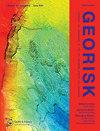考虑河道形态响应的极端气候条件下洪涝灾害评价——来自雅鲁藏布江-贾穆纳辫状平原的指示
IF 4.8
3区 工程技术
Q1 ENGINEERING, GEOLOGICAL
Georisk-Assessment and Management of Risk for Engineered Systems and Geohazards
Pub Date : 2022-10-14
DOI:10.3390/geohazards3040024
引用次数: 0
摘要
气候变化预计将在未来提高河流流量和海平面,这些近期变化可能会改变未来洪水的河流流量和沉积模式。目前的灾害评估研究在评估洪水灾害或风险时考虑到这种形态动态反应方面存在局限性。在这里,我们提出了一种基于多模型的方法来量化生活在雅鲁藏布江河坝和贾穆纳河岛屿上的最脆弱社区受气候变化影响的潜在危险参数。预测由于全球变暖的加剧,降水的时间分布格局的变化将影响河流的洪水流量和洪水波的传播特征。因此,可能会发生由海平面上升引起的大型多峰洪水或罕见洪水导致的长时间洪水的发生率增加。为了评估它,我们为雅鲁藏布江-贾穆纳河建立了一个水文形态模型Delft3D,该模型由雅鲁藏布江流域的水文模型SWAT生成,受上游水流的影响。模拟涵盖了RCP8.5情景的中等、最湿和最干条件,结果反映了近期、本世纪中叶和世纪末的洪水后果。由于气候变化,雅鲁藏布江的洪水变得更加严重、频繁和持久,预计将持续到11月底,而不是目前的9月。在评估灾害时,我们发现洪水的模式和时间与洪水的峰值同样重要,因为河流不断随着流量调整其横截面积。该研究还表明,气候引起的危害对沙洲/岛屿的影响程度不同,这取决于它们所处的位置。洪水深度大、持续时间长、泥沙淤积大,对下游沙坝的影响较大,使其更加脆弱。本文章由计算机程序翻译,如有差异,请以英文原文为准。
Assessment of Flood Hazard in Climatic Extreme Considering Fluvio-Morphic Responses of the Contributing River: Indications from the Brahmaputra-Jamuna’s Braided-Plain
Climate change is expected to raise river discharge and sea level in the future, and these near-term changes could alter the river flow regime and sedimentation pattern of future floods. Present hazard assessment studies have limitations in considering such morpho-dynamic responses in evaluating flood hazards or risks. Here, we present a multi-model-based approach to quantify such potential hazard parameters influenced by climate change for the most vulnerable communities living on river bars and islands of the Brahmaputra–Jamuna River. River flood-flow and flood wave propagation characteristics are predicted to be affected by changing temporal distribution patterns of precipitation as a result of enhanced global warming. Increased incidences of large multi-peak floods or uncommon floods resulting in long-duration floods driven by sea-level rise may happen as a result of this. To assess it, we have set up a hydromorphic model, Delft3D, for the Brahmaputra–Jamuna River forced by upstream flow, generated from a hydrological model SWAT, over the Brahmaputra basin. The simulations cover moderate, wettest, and driest conditions of the RCP8.5 scenario, and the results reflect the flooding consequences of the near-future, mid-century, and end-century. Floods in the Brahmaputra–Jamuna River are becoming more severe, frequent, and long-lasting, as a result of climate change, and are expected to last until the end of November rather than the current September timeline. While assessing the hazard, we found that the pattern and timing of the flood are as equally important as the peak of the flood, as the river continuously adjusts its cross-sectional area with the flow. The study also demonstrates that, depending on their location/position, climate-induced hazards can affect sand bars/islands disproportionally. The high flood depth, duration, and sedimentation have a significant impact on the sand bars downstream of the river, making them more vulnerable.
求助全文
通过发布文献求助,成功后即可免费获取论文全文。
去求助
来源期刊
CiteScore
8.70
自引率
10.40%
发文量
31
期刊介绍:
Georisk covers many diversified but interlinked areas of active research and practice, such as geohazards (earthquakes, landslides, avalanches, rockfalls, tsunamis, etc.), safety of engineered systems (dams, buildings, offshore structures, lifelines, etc.), environmental risk, seismic risk, reliability-based design and code calibration, geostatistics, decision analyses, structural reliability, maintenance and life cycle performance, risk and vulnerability, hazard mapping, loss assessment (economic, social, environmental, etc.), GIS databases, remote sensing, and many other related disciplines. The underlying theme is that uncertainties associated with geomaterials (soils, rocks), geologic processes, and possible subsequent treatments, are usually large and complex and these uncertainties play an indispensable role in the risk assessment and management of engineered and natural systems. Significant theoretical and practical challenges remain on quantifying these uncertainties and developing defensible risk management methodologies that are acceptable to decision makers and stakeholders. Many opportunities to leverage on the rapid advancement in Bayesian analysis, machine learning, artificial intelligence, and other data-driven methods also exist, which can greatly enhance our decision-making abilities. The basic goal of this international peer-reviewed journal is to provide a multi-disciplinary scientific forum for cross fertilization of ideas between interested parties working on various aspects of georisk to advance the state-of-the-art and the state-of-the-practice.

 求助内容:
求助内容: 应助结果提醒方式:
应助结果提醒方式:


